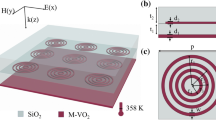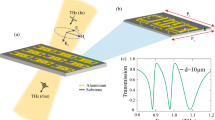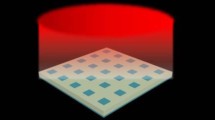Abstract
The dielectric properties of an active KTaO3 hybrid metamaterial structure and its tunability under external electric fields are investigated at room temperature by means of terahertz time-domain spectroscopy. Application of the electric field leads to an appreciable tuning of the dielectric loss, which is up to 17%. Meanwhile, the refractive index also changes appreciably. These findings are attributed to the internal space charge field in the crystal caused by the excited free carriers.
Similar content being viewed by others
Introduction
The terahertz frequency range, overlapping with many fundamental elementary excitations of physical systems such as molecular vibrations, phonons, quasi-free electrons, excitons, and magnons, has become extensively exploited during the past two decades1, 2. In order to achieve active control of the terahertz wave propagation, it is an important issue to investigate tuning properties of various materials and structures in the terahertz regime. Metamaterials, offering unprecedented functionalities to manipulate electromagnetic waves, have become a research hotspot in recent years. Through incorporation of active media, the exotic electromagnetic behavior of metamaterials could be dramatically empowered by dynamic control3,4,5. Ranjan Singh et al. reported complex oxide based tunable active terahertz metamaterials for different applications such as photoswitching6,7,8,9,10.
Potassium tantalate (KTaO3, KTO), like Strontium titanate (SrTiO3, STO), is one of the most popular incipient ferroelectrics with interesting potential for technical application, in which the quantum fluctuations at low temperatures prevent a displacive ferroelectric phase transition to occur. Recently, research on properties of KTO in the terahertz spectral range has drawn the attention of many researchers11,12,13,14,15,16,17. V. Skoromets et al. prepared a polycrystalline TO thin film by using a chemical solution deposition method, and measured its permittivity at terahertz frequencies at different temperatures11. Sebastjan Glinsĕk et al. reported the broad-band dielectric properties and lattice dynamics of KTO ceramics, revealing that the soft mode frequency agrees well with the values that in single crystal12. We have investigated the dielectric property of KTO single crystals in the terahertz range, and found that the dielectric constant can be modulated by an optical field at room temperature, which decreased ~3.5% with light excitation power of 600 mW13.
Thus, the dielectric properties in bulk KTO under electrical field obtained by terahertz spectroscopy have rarely been explored, and only a few observations of the tunability of KTO single crystal at room temperature has been reported up to now. V Skoromets et al. studied the electric-field tunability of the dielectric properties of KTO single crystal by using terahertz spectroscopy in a broad temperature range18, the relative change of the real part of the permittity could reach up to ~12% at 60 K upon the electric field of 50 kV cm−1. Moreover, additional effects could also be observed in the crystal with designed structures, which cannot be described by the conventional model. P. Kužel et al. have developed an approach with an interdigited electrode structure to be used to determine the electric field dependence of the complex permittivity of a STO thin film on a sapphire substrate19. With a 100 kV/cm electric field applied, they demonstrated up to 10% variation of the film permittivity at 300 GHz at room temperature. In this letter, we present a KTO based hybrid metamaterial structure and the tunability of its dielectric properties under external electrical excitation. We observe that a low DC bias would change both the refractive index and absorption coefficient, consequently modulate the terahertz response in the hybrid structure. Variation of absorption coefficient at the peak could reach up to 17%. The proposed KTO metamaterial offers a reference for developing high-performance real world photonic devices for terahertz technology.
Methods
The KTO crystals (MTI Corporation) are 10 mm × 10 mm × 0.535 mm in dimensions with an orientation of <100>. The periodic interdigitated electrode metastructure is patterned using conventional photolithography on the KTO bulk crystal, followed by 180-nm Aluminum film deposition. We used a photoconductive switch based 8 f terahertz time-domain spectrometer (THz-TDS) to measure the transmittance spectra through the KTO hybrid structure, as shown in Fig. 1. The samples are excited by a 3.5-mm beam waist at normal incidence with a sample area of 1 cm2. The detail schematic of the unit metastructure of with parameters is shown in Fig. 1(b). With the electric field perpendicular to the interdigitated electrode, the transmission in time and frequency domain are measured for the sample and reference. A free space signal is used as the reference. By applying a constant electrical voltage, we discovered that the transmitted terahertz signals could be dynamically modulated. All measurements were carried out at room temperature in a dry air environment in order to eliminate the absorption of terahertz waves by water vapor present in the atmosphere. No arcing is observed during the measurement. The electrode separation is 40 μm, so the maximum electric field intensity is less than 30 kV/cm.
Results and Discussion
Figure 2 shows typical experimental results of the terahertz time domain waveforms passing through the sample. The time lag between the reference and sample is around 30 ps, as seen in Fig. 1. The signal waveforms transmitted through the KTO hybrid metamaterials show appreciable change with the increase of bias voltage. For example, when the applied bias is 138 V, the transmittance waveform shifts about 1.5 ps and the amplitude increases from 9.5 to 10.8, compared to that without electric excitation.
Through a Fourier transform, we calculated the complex transmittances and the intrinsic phases in frequency domain from the waveforms in Fig. 2. Figure 3 shows examples of terahertz complex dielectric spectra of the samples under different external electric fields. The detectable frequency range was from 0.1 to 0.7 THz (3.3 cm−1 to 23.1 cm−1), since the KTO samples are nearly opaque above ~1 THz. At zero gate current, a pronounced LC resonance approximately at 0.23 THz could be observed, which is determined by f 0 = ω/2π = 1/2π (LC)1/2 20. Here L is the inductance of the square loop and C is the capacitance of the gap. Both phase and transmittance amplitude increase with an increasing pump voltage, namely, the corresponding refractive index and dielectric loss decrease with the voltage growing.
Figures 2 and 3(a) demonstrate that the phase and time position of the transmittance signals also show differences, indicating that the refractive index changes considerably (5~8%) with external electric field. Compared to our previous work13, the new structure, delivering a modulation depth of more than 17% for absorption loss, greatly enhanced the dielectric tunability of the KTO crystal. Figure 3(c) shows simulated electric field distribution of the LC resonator structure at resonance frequency using CST Microwave studio frequency-domain solver. The LC resonator design supports strongly confined electric field in the capacitive gap at fundamental inductive-capacitive resonance mode.
In order to illustrate the bias induced ferroelectric properties in KTO, it is worthwhile to study the variation of its dielectric loss under the appearance of external electric fields. The thickness of the metal structure is 180 nm, which is much smaller than that of the KTO crystal (0.535 mm). For simplicity, we considered the LC resonator-KTO two-layer structure as a uniform effective dielectric media, the imaginary part of permittivity (dielectric loss) was then retrieved from the terahertz transmittance spectra. Figure 4(a) shows the imaginary part of permittivity of the KTO hybrid metamaterial and its variation under external voltages at room temperature. Figure 4(b) demonstrates modulation of the imaginary part of permittivity as a function of the applied electric power and its fit. In the frequency range of 0.1–0.7 THz, the active KTaO3 hybrid metamaterial structure does not show a giant dielectric loss, the magnitude of ε” is about 3–15, nearly the same with that of KTO crystal without any structure13. We notice that the peak positon of ε” shifts obviously with different levels of voltage bias, indicative of the tuning of LC resonance frequency. The maximum frequency shift could reach up to 0.02 THz when the applied voltage is up to 138 V. The measured dielectric loss is found to be tunable by up to 17% via the application of an external electric field, and the dielectric constant nonlinearly decreases with increaseing voltage bias. The measured dielectric loss of the hybrid structure versus applied voltage at the peak (corresponding to the resonance frequency) are shown in Fig. 4, which fits well with the following empirical expression21:
where ε” 0 and ε”(V) are the imaginary part of dielectric constants under zero electric field and under the applied bias, respectively, and α is the anharmonic coefficient. The anharmonic coefficient is assumed to be an order parameter of the anharmonic interactions, and we can fit the profile well using α = 8.476 × 10−9 at the peak of ε”. The fitting results using equation (1) are shown as solid lines in Fig. 4(b).
It is noticed that with only parallel electrodes, a broadband tuning effect for the sample could be achieved, but we still believe that the resonators are necessary. Firstly, the active LC metasurface can be generalized to function at defined resonance frequencies. In the measurement, the resonance frequency shifted about 0.02 THz with the applied bias, which may be used for phase tuning. Secondly, the LC resonator design strongly supports confined electric field in the capacitive gap at fundamental LC resonance mode, indicating that the tuning effect could be enhanced more or less at resonance frequency (maybe not obvious).
The interesting characteristics observed in the active modulation of the absorption coefficient in the metamaterial are mainly attributed to the modification by the free carriers in the hybrid structure with varying gate voltages. Usually there are only Ta5+ ions in the KTO single crystals; the local defects could also result in the presence of Ta4+ ions in the samples22, 23. We neglect thermal excitations here. When a voltage bias is applied to the sample, a high electric field intensity for the KTO crystal could be acquired, and a lot of free electrons would be generated because there is an exchange of electrons between Ta4+ and Ta5+ ions. The electrons in Ta4+ ions can hop to the conduction band, they migrate in a preferred direction, and finally are captured by the trap level of Ta5+. The dominant charge driving force during this process is supposed to be the voltaic effect. Drift and diffusion could also have contribution to the movement of the electrons. The migration process would lead to a redistribution of carriers in the KTO crystal, then the space displacement of carriers leads to an internal space charge field that shields the external electric field until a new equilibrium is reached. This internal space charge field changes the dielectric properties of the sample through electro-optic effect21, 24, as shown in Fig. 4.
We should also clarify that in the process, the quantity of free carriers does not change, so the tuning of complex dielectric constant can be attributed to the electro-optic effect. If the tuning effect mainly comes from the carriers, the absorption coefficient would be tuned significantly, but the real part of permittivity will not show obvious change. In this measurement, both the real and imaginary parts of the dielectric constant change simultaneously with the same trend with electric fields, so we believe that the electro-optic effect plays a dominant role in the tuning effect. Some of our previous work also supported this conclusion25.
Summary
We investigated the frequency dependence of dielectric response of a new LC resonator-KTO metamaterial and its electric-field-induced tunability by using THz-TDS at room temperature. An appreciable variation of absorption coefficient in KTO crystal was also demonstrated with different levels of external electric fields. This property originates from the voltaic effect caused by the electric-induced free carriers as well as their shielding effect, leading to an internal space charge field. It is supposed that the two mechanisms complement with each other, resulting in the observed dielectric tuning behaviors of KTO. Such a variation in the dielectric response could be used in phase or amplitude modulator in the terahertz regime. The findings would illuminate further applications for novel functional integrated devices based on KTO or other ferroelectric materials.
References
Hangyo, M., Tani, M. & Nagashima, T. Terahertz time-domain spectroscopy of solids: a review. J. Infrared Millim. Waves 26(12), 1661–1690 (2005).
Tonouchi, M. Cutting-edge terahertz technology. Nature photonics 1(2), 97–105 (2007).
Zheludev, N. I. & Kivshar, Y. S. From metamaterials to metadevices. Nature materials 11(11), 917–924 (2012).
Smith, D. R., Pendry, J. B. & Wiltshire, M. C. Metamaterials and negative refractive index. Science 305(5685), 788–792 (2004).
Shalaev, V. M. Optical negative-index metamaterials. Nature photonics 1(1), 41–48 (2007).
Srivastava, Y. K., Manjappa, M., Krishnamoorthy, Harish, N. S. & Singh, R. Accessing the High-Q Dark Plasmonic Fano Resonances in Superconductor Metasurfaces. Adv. Optical Materials 4(11), 1875–1881 (2016).
Manjappa, M. et al. Active Photoswitching of Sharp Fano Resonances in THz Metadevices. Adv. Materials 29(3), 1603355 (2017).
Singh, R. & Zheludev, N. Superconductor photonics. Nature photonics 8(9), 679–680 (2014).
Singh, R., Azad, A. K., Jia, Q. X., Taylor, A. J. & Chen, H. T. Thermal tunability in terahertz metamaterials fabricated on strontium titanate single-crystal substrates. Opt. lett. 36(7), 1230–1232 (2011).
Gu, J. et al. An active hybrid plasmonic metamaterial. Opt. materials express 2(1), 31–37 (2012).
Skoromets, V. et al. Ferroelectric phase transition in polycrystalline KTaO3 thin film revealed by terahertz spectroscopy. Appl. Phys. Lett. 99(5), 052908 (2011).
Glinšek, S. et al. Lattice dynamics and broad-band dielectric properties of the KTaO3 ceramics. J. Appl. Phys. 111(10), 104101 (2012).
Wu, L. et al. Modulation of dielectric properties of KTaO3 in terahertz region via 532nm continuous-wave laser. Opt. Mat. Express 4(12), 2595–2601 (2014).
Ichikawa, Y., Nagai, M. & Tanaka, K. Direct observation of the soft-mode dispersion in the incipient ferroelectric KTaO3. Phys. Rev. B 71(9), 092106 (2005).
Ichikawa, Y. & Tanaka, K. Influence of lattice polarizability on interacting Li-induced dipoles distributed in incipient ferroelectric KTaO3. Phys. Rev. B 77(14), 144102 (2008).
Pashkin, A., Železný, V. & Petzelt, J. Infrared spectroscopy of KTa1−xNbxO3 crystals. J. Phys.: Condens. Matter 17(25), 265–270 (2005).
Trepakov, V. et al. An optical and dielectric spectroscopy study of Er3+-doped KTaO3. Phys. Status Solidi B 248(12), 2908–2915 (2011).
Skoromets, V., Kadlec, C., Němec, H., Fattakhova-Rohlfing, D. & Kužel, P. Tunable dielectric properties of KTaO3 single crystals in the terahertz range. J. Phys. D: Appl. Phys 49(6), 065306 (2016).
Kužel, P., Kadlec, F., Petzelt, J., Schubert, J., & Panaitov, G. (2007). Highly tunable SrTiO3/DyScO3 heterostructures for applications in the terahertz range. Appl. Phys. Lett. 91(23), 232911 (2007).
Xu, N., Singh, R. & Zhang, W. Collective coherence in nearest neighbor coupled metamaterials: A metasurface ruler equation. J. Appl. Phys. 118(16), 163102 (2015).
Johnson, K. M. Variation of dielectric constant with voltage in ferroelectrics and its application to parametric devices. J. Appl. Phys. 33(9), 2826–2831 (1962).
Laguta, V. V. et al. Photochromic centers and impurities in nominally pure KTaO3 and K1−xLixTaO3. Phys. Rev. B 52(10), 7102–7107 (1995).
Laguta, V. V. et al. Symmetry-breaking Ta4+ centers in KTaO3. Phys. Rev. B 58(1), 156–163 (1998).
Chen, F. S. Optically induced change of refractive indices in LiNbO3 and LiTaO3. J. Appl. Phys. 40(8), 3389 (1969).
Wu, L. et al. A new Ba0.6Sr0.4TiO3-silicon hybrid metamaterial device in terahertz regime. Small 12(19), 2610–2615 (2016).
Acknowledgements
This work is supported by the Natural Science Foundation of Tianjin (Grants No. 15JCQNJC02200), the National Natural Science Foundation of China (Grants No. 61675147), and the open project of Key Laboratory of Micro Opto-electro Mechanical System Technology, Tianjin University, Ministry of Education (Grants No. MOMST2016-08).
Author information
Authors and Affiliations
Contributions
Conceived idea- L.W. Performed experiments- L.W. and N.X. Wrote manuscript- L.W., Q.S. and W.Z. Prepared figures- J. Liu and H.L. Critical reading of manuscript- C.D., X.Z., Z.X., J.Y., J. Li and X.D.
Corresponding authors
Ethics declarations
Competing Interests
The authors declare that they have no competing interests.
Additional information
Publisher's note: Springer Nature remains neutral with regard to jurisdictional claims in published maps and institutional affiliations.
Rights and permissions
Open Access This article is licensed under a Creative Commons Attribution 4.0 International License, which permits use, sharing, adaptation, distribution and reproduction in any medium or format, as long as you give appropriate credit to the original author(s) and the source, provide a link to the Creative Commons license, and indicate if changes were made. The images or other third party material in this article are included in the article’s Creative Commons license, unless indicated otherwise in a credit line to the material. If material is not included in the article’s Creative Commons license and your intended use is not permitted by statutory regulation or exceeds the permitted use, you will need to obtain permission directly from the copyright holder. To view a copy of this license, visit http://creativecommons.org/licenses/by/4.0/.
About this article
Cite this article
Wu, L., Liu, J., Li, H. et al. Active KTaO3 hybrid terahertz metamaterial. Sci Rep 7, 6072 (2017). https://doi.org/10.1038/s41598-017-05529-0
Received:
Accepted:
Published:
DOI: https://doi.org/10.1038/s41598-017-05529-0
Comments
By submitting a comment you agree to abide by our Terms and Community Guidelines. If you find something abusive or that does not comply with our terms or guidelines please flag it as inappropriate.







